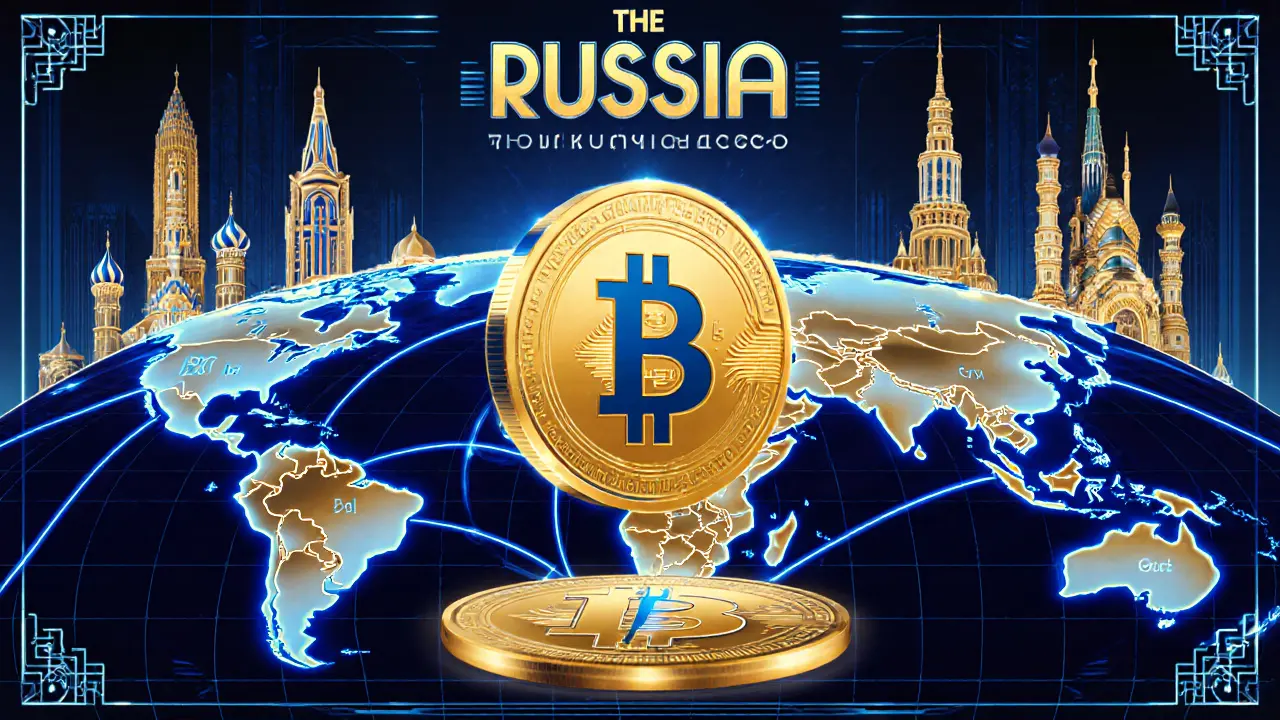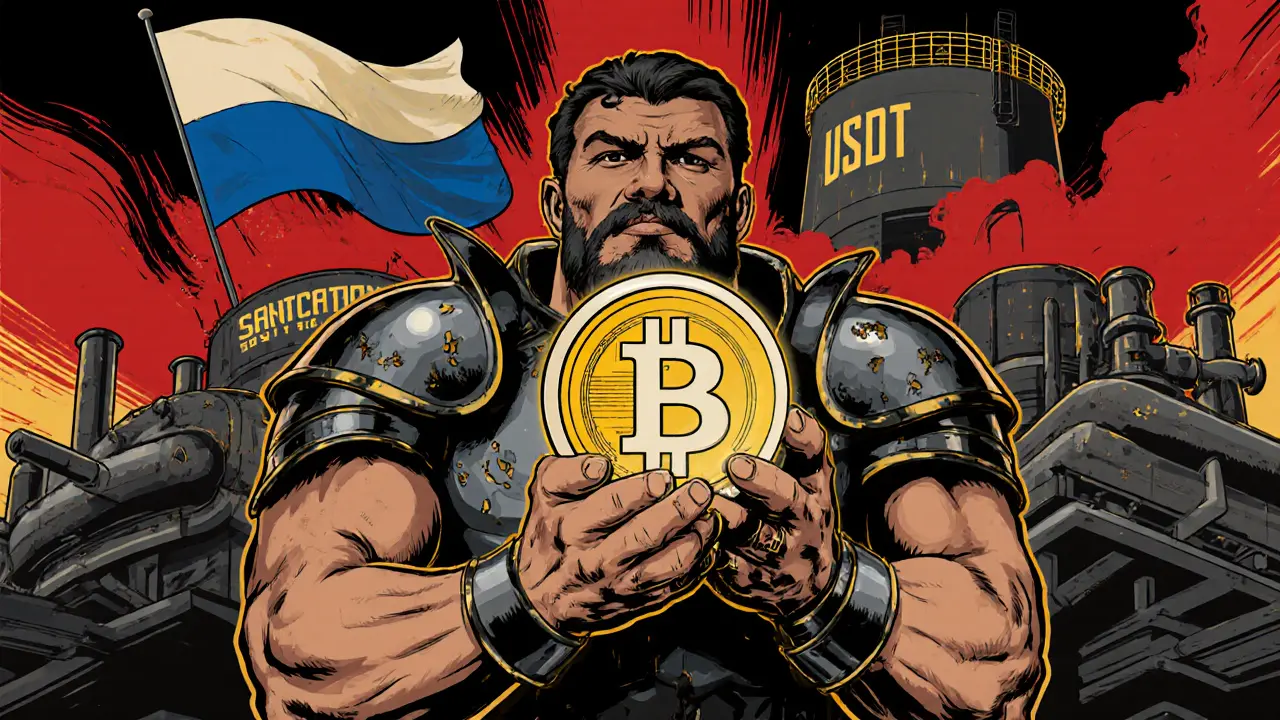Cross-Border Crypto Payment Calculator
Calculate Trade Transaction Value
Enter your transaction amount to see potential value changes when using Bitcoin/ETH versus USDT under Russia's new regulations.
For years, Russia banned Bitcoin and other cryptocurrencies outright. Then, in 2024, everything changed. Now, Russian companies can legally use Bitcoin, Ethereum, and stablecoins to pay for oil, gas, and other goods abroad - but only under strict rules. This isn’t about letting ordinary people buy crypto on their phones. It’s about using digital assets as a weapon against Western sanctions. And it’s working.
Why Russia Changed Its Mind on Crypto
In 2022, after the invasion of Ukraine, Western countries froze Russian banks out of SWIFT, blocked access to dollar reserves, and cut off financial lifelines. Russia needed a way to keep trading. Traditional banking channels were closing. So, the government turned to crypto - not as a financial revolution, but as a survival tool. President Putin didn’t suddenly become a Bitcoin fan. He gave the Finance Ministry and Central Bank one order: find a way to keep exports flowing without using the U.S. dollar or European banking systems. The result? Federal Law No. 221-FZ, a three-year pilot program launched in September 2024. It’s not a legalization of crypto. It’s a controlled experiment.Who Can Use Crypto for Cross-Border Payments?
Only legal entities - companies - are allowed to use crypto for international payments. Individuals? Still banned. You can’t send Bitcoin to your cousin in Turkey or pay for an online service with Ethereum. The law is crystal clear: this is for big business, not consumers. To qualify, a company must be part of the official pilot program approved by the Bank of Russia. Only a few hundred firms have been granted access so far. Most are energy giants, metal exporters, and arms suppliers - the same industries hit hardest by sanctions. The approved cryptocurrencies are limited: Bitcoin (BTC), Ethereum (ETH), Tether (USDT), and a few other stablecoins tied to the ruble or Chinese yuan. No random altcoins. No privacy coins like Monero. The government wants traceable transactions, not anonymous ones.How It Actually Works
Here’s the step-by-step reality:- A Russian oil company signs a contract with a buyer in India.
- The buyer agrees to pay in USDT, not dollars.
- The Russian company uses a certified digital asset platform - like the one operated by Sberbank or a state-approved fintech - to convert rubles into USDT.
- The transaction is recorded on a government-monitored ledger. Every detail: sender, receiver, amount, timestamp, origin of funds.
- The Indian buyer receives the USDT and converts it to local currency through a partner exchange.

Why Stablecoins Like USDT Are the Real Stars
Bitcoin is flashy, but it’s not the workhorse here. Volatility makes it risky for trade. A $10 million oil deal paid in Bitcoin could lose or gain $2 million in value before settlement. That’s not acceptable for state-backed energy firms. That’s why Tether (USDT) dominates. It’s pegged to the U.S. dollar, so prices stay stable. Russian companies use USDT not because they trust the dollar - they use it because it’s the only stable, globally accepted digital asset that bypasses Western banks. It’s a workaround, not a replacement. Even ruble-backed stablecoins are now being tested. The Bank of Russia has quietly launched its own digital ruble pilot with 12 banks. By mid-2024, over 100,000 transactions had been processed. It’s still small, but growing fast. The goal? To eventually replace USDT with a state-controlled alternative.Who’s Getting Rich - and Who’s Getting Locked Out
The winners? Large corporations with deep pockets and legal teams. The A7 Group, linked to a sanctioned Russian bank, is already using Tether for cross-border deals. Rosneft and Gazprom are quietly shifting export invoices to crypto. Their profits are up. Their reliance on Western finance is down. The losers? Ordinary Russians. You can’t open a crypto wallet at Sberbank. You can’t buy Bitcoin on a local exchange. The government has blocked all domestic crypto trading platforms. If you want to own Bitcoin, you have to use a foreign site - and risk getting fined or worse. Even investment access is tightly controlled. Only “highly qualified investors” can buy crypto derivatives. That means you need at least 100 million rubles ($1.1 million) in assets or an annual income over 50 million rubles ($550,000). In a country where the median income is under $15,000 a year, that’s a tiny elite.The Hidden Costs: Compliance, Risk, and Surveillance
This system isn’t free or easy. Companies must follow strict AML and KYC rules. Every transaction must be documented. Every counterparty must be verified. The Bank of Russia requires real-time reporting of all crypto flows. Firms hire compliance officers just to handle this. There’s also the risk of being caught violating the rules. The Central Bank has proposed criminal penalties for unauthorized crypto use - up to five years in prison. That’s not empty talk. In early 2025, a Moscow-based trading firm was fined 300 million rubles ($3.3 million) for using Bitcoin without a license. And while the system is designed to prevent money laundering, it’s still vulnerable. Many crypto exchanges operate outside Russia. Russian users still hold over $25 billion in digital assets - mostly on Binance, Bybit, and other offshore platforms. The government knows this. It just doesn’t have the tools to stop it.
What Comes Next?
The pilot program runs until 2027. After that, the government will decide whether to make it permanent. There are signs they will. By September 2026, large Russian companies will be required to start using the Digital Ruble for internal payments. By 2028, every merchant - even your local grocery store - will have to accept it. That’s the real endgame: replacing cash and cards with a state-controlled digital currency. Meanwhile, the Central Bank is preparing to let investment funds buy Bitcoin futures in 2026. That’s a big deal. It means institutional money is coming in - but only for those who already have billions.Is This a Global Trend?
Russia isn’t alone. Iran, Venezuela, and North Korea have all used crypto to bypass sanctions. But Russia is the first major economy to build a legal, state-managed system around it. It’s not hiding crypto - it’s weaponizing it. Western regulators are watching closely. The EU and U.S. are tightening rules on stablecoin transactions involving Russian entities. They’re trying to cut off the flow. But Russia has already shifted its trade to China, India, Turkey, and the UAE - all countries that don’t care about U.S. sanctions. This isn’t just about money. It’s about power. Russia is proving you can build a parallel financial system - even under siege.What This Means for the Rest of the World
If Russia succeeds, other sanctioned nations will follow. The dollar’s dominance won’t vanish overnight. But it will erode - slowly, steadily, one crypto invoice at a time. For businesses outside Russia, the message is clear: if you want to trade with Russian partners, you’ll need to understand crypto payments. You’ll need to know which platforms are approved. You’ll need to track compliance. Ignoring this isn’t an option anymore. For everyday people? Don’t expect to use Bitcoin to pay your rent. But if you’re in international trade, the rules have changed. Crypto isn’t just a speculative asset anymore. It’s a tool of global economics - and Russia is leading the way.Can Russians buy Bitcoin for personal use?
No. Personal crypto purchases are still illegal in Russia. You can’t buy Bitcoin on a local exchange or use it to pay for goods or services domestically. Any crypto holdings by individuals are held on foreign platforms, and the government actively discourages this. While enforcement is difficult, using crypto for personal transactions can lead to fines or legal trouble.
Which cryptocurrencies are allowed in Russia’s cross-border program?
Only a short list of approved assets: Bitcoin (BTC), Ethereum (ETH), Tether (USDT), and select ruble- or yuan-backed stablecoins. The Bank of Russia controls the list and can add or remove assets at any time. Privacy coins like Monero or Dogecoin are explicitly banned.
Is the Digital Ruble the same as Bitcoin?
No. The Digital Ruble is Russia’s central bank digital currency (CBDC), fully controlled by the Bank of Russia. It’s not decentralized like Bitcoin. It’s more like a digital version of cash, but with built-in tracking and restrictions. The Digital Ruble is meant for domestic payments, while Bitcoin is only allowed for cross-border trade under strict conditions.
Can foreign companies receive crypto payments from Russia?
Yes - but only if they’re dealing with a Russian company that’s part of the official pilot program. The payment must go through a certified Russian digital asset platform. Foreign businesses can’t initiate crypto payments to Russia. They can only receive them under the government’s regulated framework.
What happens after the pilot program ends in 2027?
The government plans to make cross-border crypto payments permanent - but likely with even tighter controls. The goal is to fully integrate digital assets into Russia’s financial infrastructure while keeping domestic use restricted. Expansion may include allowing more asset types, but only for qualified entities. Ordinary citizens won’t see any change.




Robin Hilton
November 4, 2025 AT 07:44This is pure economic warfare disguised as innovation. Russia isn't adopting crypto-they're weaponizing it. The fact that they're using USDT instead of Bitcoin tells you everything: they don't trust volatility, they trust control. And they're using Western tools to bypass Western sanctions. Hypocritical? Absolutely. Effective? Unquestionably.
Grace Huegel
November 6, 2025 AT 04:37It's fascinating how the same people who screamed about crypto being 'unregulated' and 'dangerous' are now quietly terrified of its geopolitical implications. The West built the system. Now it's being used against them. Irony doesn't even begin to cover it.
Nitesh Bandgar
November 6, 2025 AT 10:21Ohhhhh, so now Russia is the crypto kingpin??!!?? The same country that jailed people for holding Bitcoin?!! The same government that banned exchanges and called it 'financial terrorism'?!! Now they're using USDT like it's their national currency??!! I'm not just shocked-I'm emotionally shattered!! This is the most beautiful, terrifying, chaotic, poetic, dystopian, hilarious, tragic, genius, insane thing I've ever seen in my entire life!!
Jessica Arnold
November 7, 2025 AT 02:36The structural irony here is profound: a state that demonizes decentralization is now leveraging it as the most centralized financial instrument imaginable. The Digital Ruble is the logical endpoint of this paradox-a sovereign digital currency designed to eliminate anonymity while preserving state control. What we're witnessing isn't crypto adoption-it's the institutionalization of financial authoritarianism under the guise of modernization.
Chloe Walsh
November 8, 2025 AT 10:51So let me get this straight… you can’t buy Bitcoin to pay for your Netflix subscription but your state-owned oil company can use it to buy machinery from India?? That’s not a policy that’s smart-it’s just cruel. It’s like saying ‘you can’t eat the cake but the president can have the whole bakery’… and then calling it economic sovereignty. I mean… wow. Just wow. This is literally the most messed up thing I’ve ever read
Stephanie Tolson
November 9, 2025 AT 01:52This is actually a brilliant case study in adaptive resilience. When you're cut off from the global system, you don't wait for permission-you build your own lanes. The fact that Russia chose stablecoins over speculative assets shows strategic thinking. This isn't about ideology, it's about survival. And if other nations follow suit, we're looking at the beginning of a multipolar financial order. Not everyone will like it, but it's coming anyway.